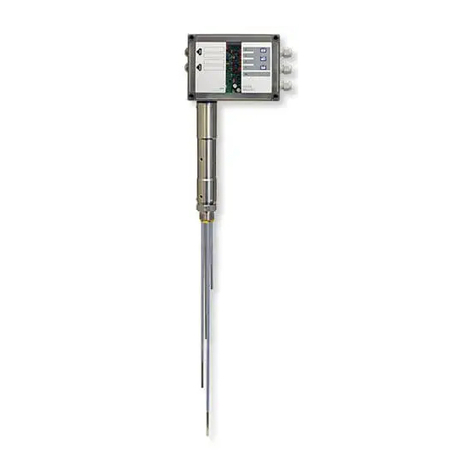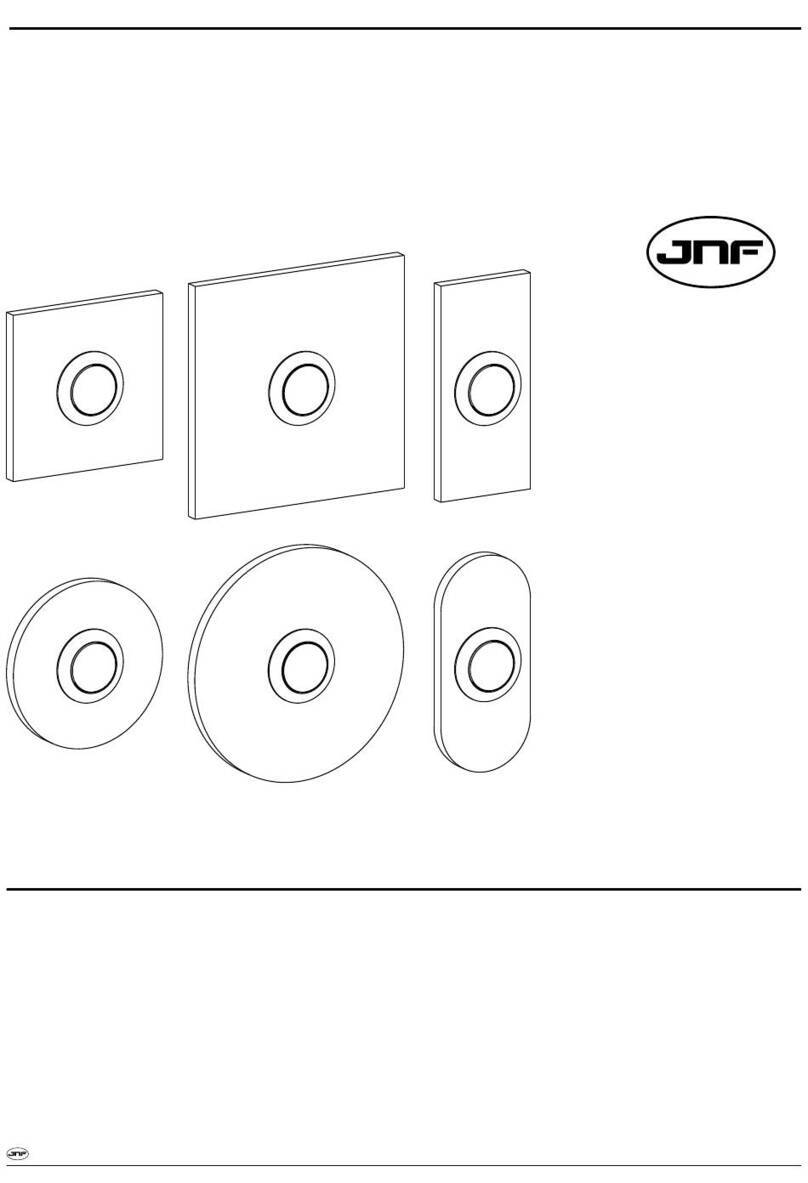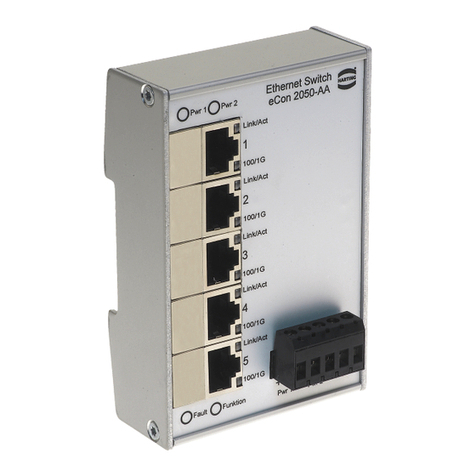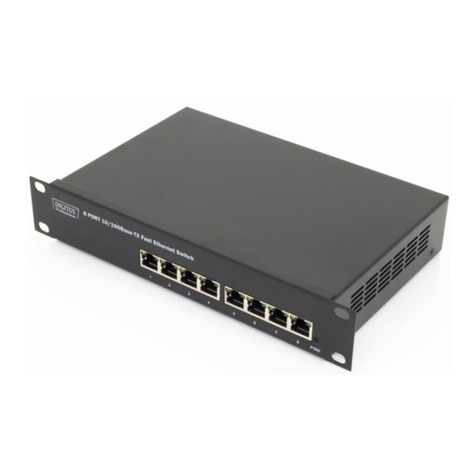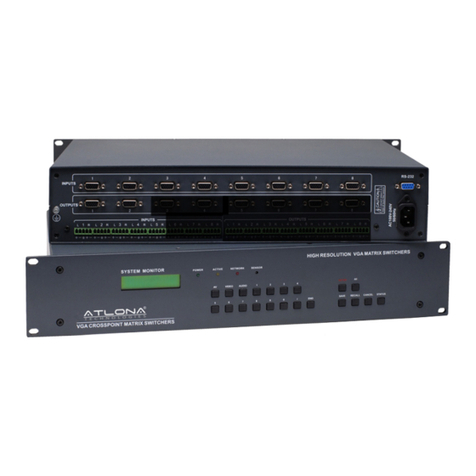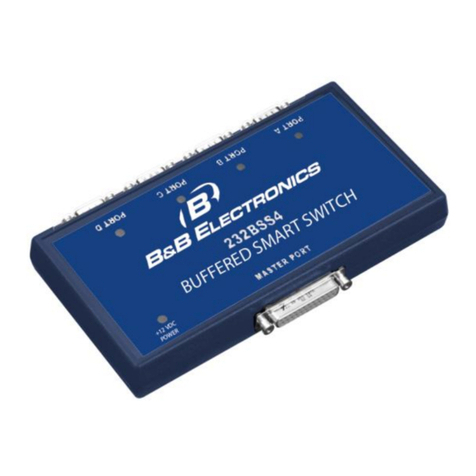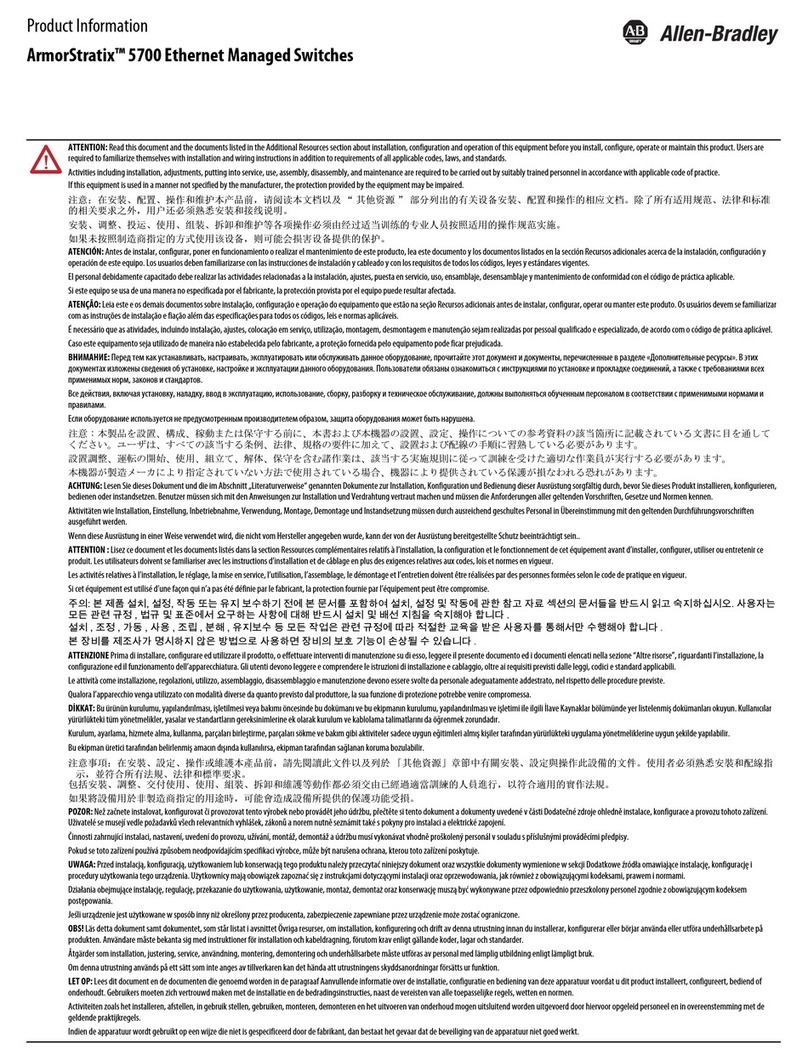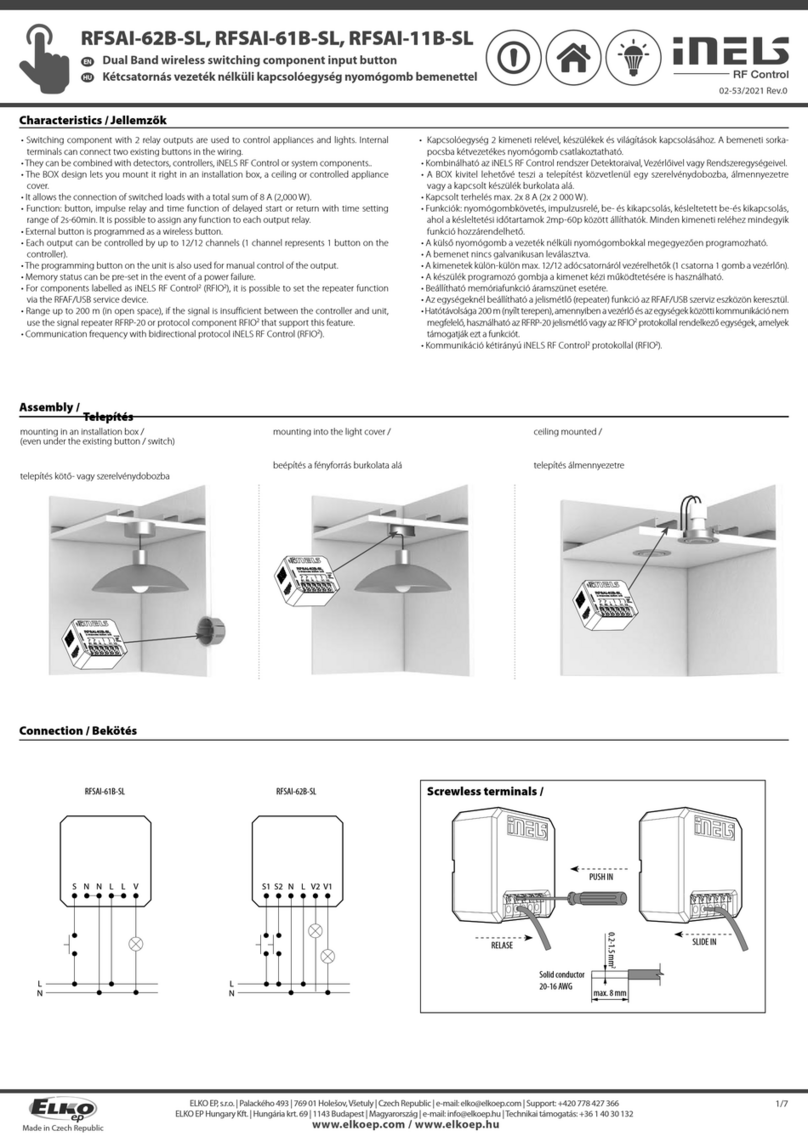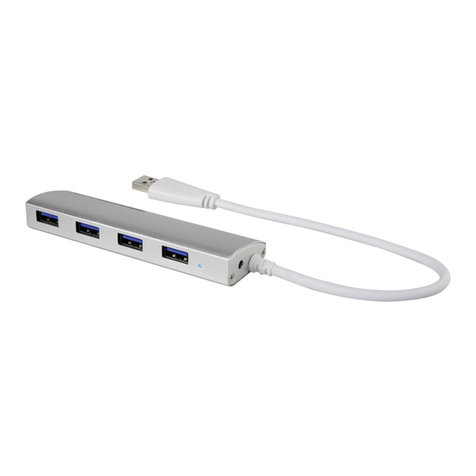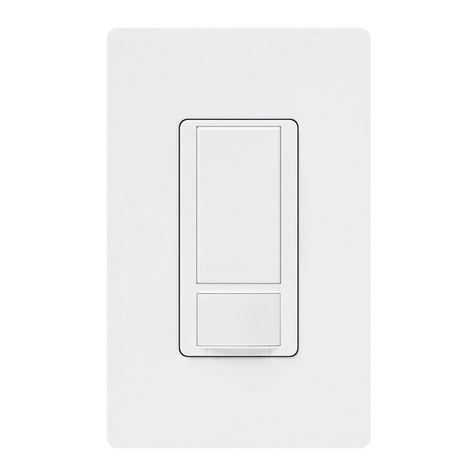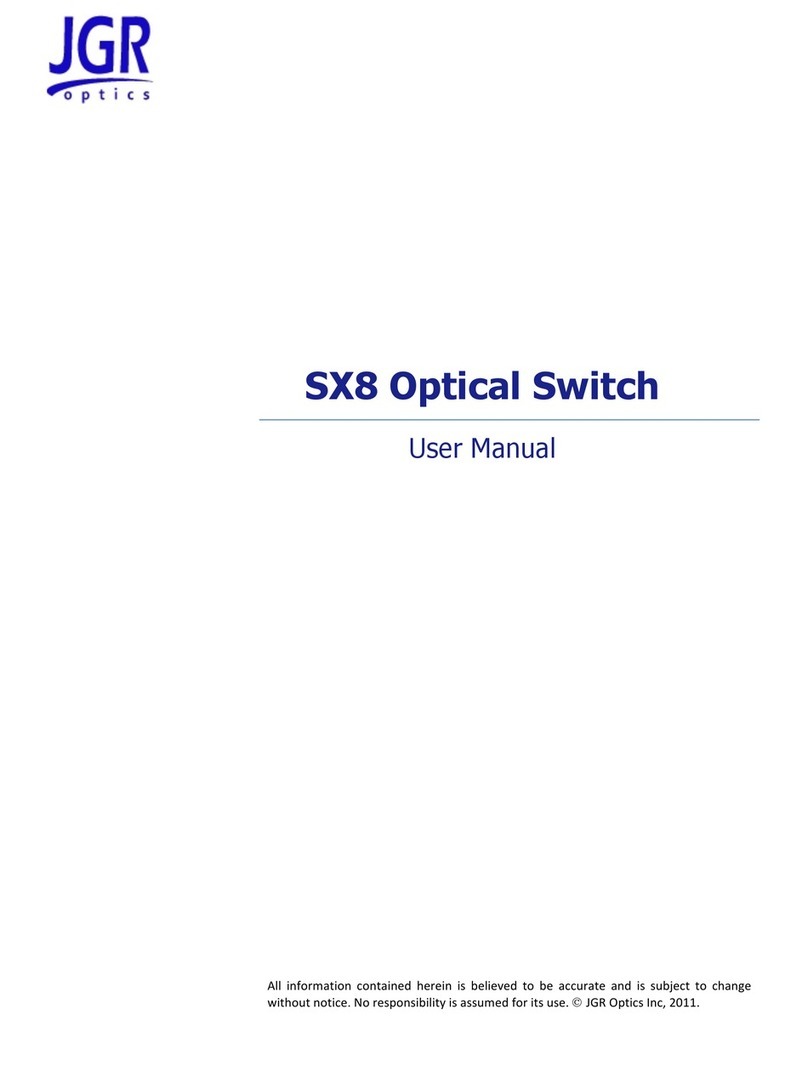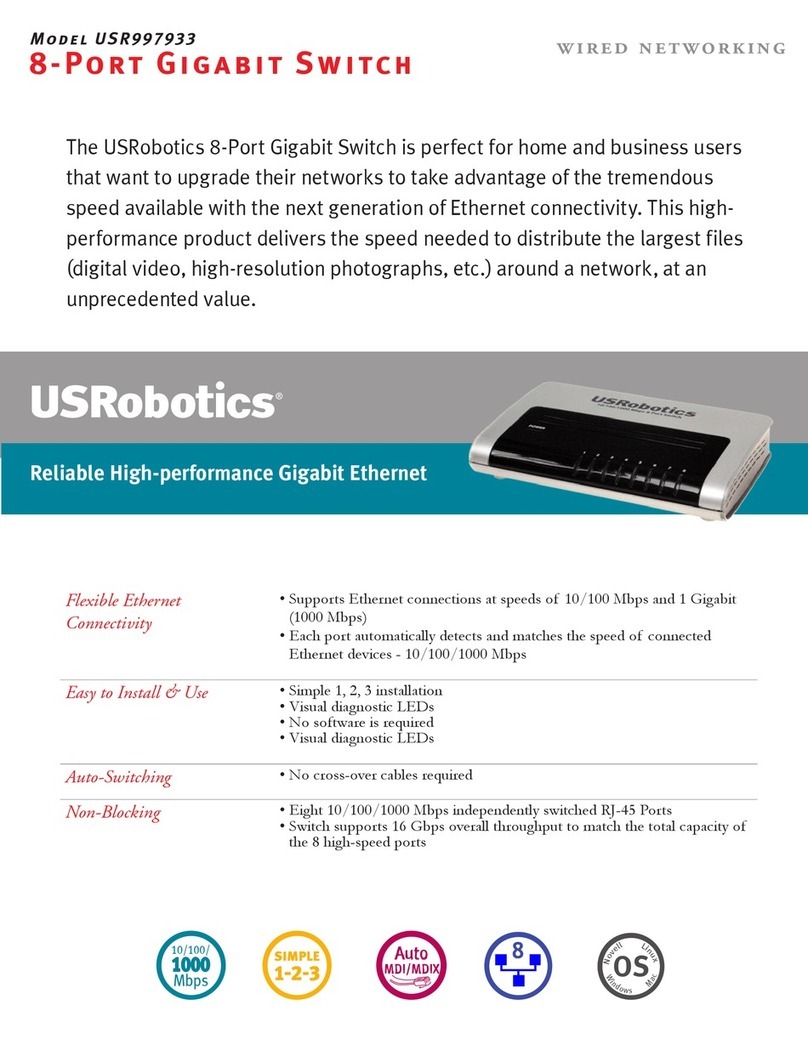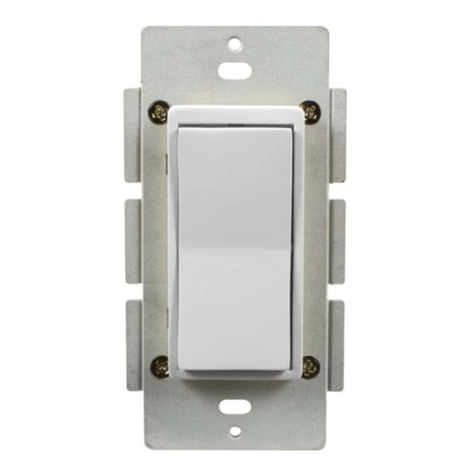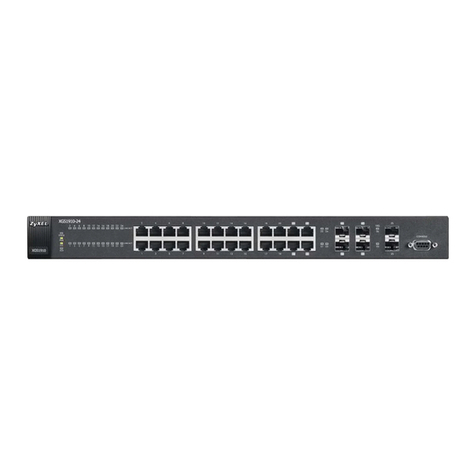GESTRA LRS 1-50 User manual

EN
English
Conductivity Switch
LRS 1-50
Original Installation &
Operating Manual
819223-03

2LRS 1-50 - Installation & Operating Manual - 819223-03
Contents
Page
Important notes
Usage for the intended purpose...............................................................................................................4
Function..................................................................................................................................................4
Safety note..............................................................................................................................................5
Directives and standards
EU Pressure Equipment Directive 2014/68/EU.........................................................................................6
VdTÜV Bulletin “Wasserüberwachung 100” (Water Monitoring 100).........................................................6
LVD (Low Voltage Directive) and EMC (Electromagnetic Compatibility) .....................................................6
ATEX (Atmosphère Explosible) .................................................................................................................6
Notes on the Declaration of Conformity/Manufacturer’s Declaration ...................................................6
Technical data
LRS 1-50 ................................................................................................................................................7
Product package.....................................................................................................................................8
Name plate/identification ........................................................................................................................8
Installation
Installation in the door of the control cabinet ...........................................................................................9
Dimensions of LRS 1-50 .......................................................................................................................10
Key .......................................................................................................................................................10
Installation in a control cabinet..............................................................................................................10
In the control cabinet: Wiring the conductivity switch
Wiring diagram for conductivity switch LRS 1-50 ..................................................................................11
Key .......................................................................................................................................................11
Supply voltage connection.....................................................................................................................12
Connection of output contacts...............................................................................................................12
Connecting an LRG 12-2, LRG 16-4, LRG 17-1 or LRG 19-1 conductivity electrode
and TRG 5-.. resistance thermometer....................................................................................................12
Connecting an LRG 16-9 conductivity electrode ....................................................................................12
In the system: Wiring the conductivity electrode
Connecting an LRG 12-2, LRG 16-4, LRG 17-1 or LRG 19-1 conductivity electrode
and TRG 5-.. resistance thermometer....................................................................................................13
Connecting an LRG 16-9 conductivity electrode ....................................................................................13

3
LRS 1-50 - Installation & Operating Manual - 819223-03
Contents
Page
continued
Factory settings ..................................................................................................................................14
Changing the factory settings
Changing the unit of measurement........................................................................................................14
Operating the conductivity switch
Meaning of codes on the 7-segment display .........................................................................................15
Bringing into service
Setting parameters................................................................................................................................16
Setting switchpoints and parameters ....................................................................................................17
Operation, alarm and testing
Checking the displays and function of the MIN/MAX output contacts .....................................................18
Password protection..............................................................................................................................19
Troubleshooting
Indications, diagnosis and remedies......................................................................................................20
Further information
Action against high-frequency interference ...........................................................................................21
Replacing/taking the equipment out of service ......................................................................................21
Disposal................................................................................................................................................21

4LRS 1-50 - Installation & Operating Manual - 819223-03
Important notes
Usage for the intended purpose
The LRS 1-50 conductivity switch is used in combination with the LRG 1.-.. conductivity electrodes
as a limit switch, e.g. in steam boilers and hot water installations and in condensate and feedwater
tanks. The conductivity switch indicates when a MIN and MAX conductivity has been reached.
The LRS 1-50 conductivity switch can be combined in a circuit with the LRG 12-1, LRG 16-4, LRG 16-9,
LRG 17-1 and LRG 19-1 conductivity electrodes.
Function
In combination with the LRG 1.-.. conductivity electrode, the LRS 1-50 conductivity switch measures
the electrical conductivity of conductive fluids. LRG 12-2, LRG 16-4, LRG 17-1, LRG 19-1 conductivity
electrodes can be connected, or the LRG 16-9 model with integrated resistance thermometer for meas-
uring the fluid temperature. A separate Pt100 resistance thermometer may also be used to measure the
temperature.
When the LRG 1.-.. conductivity electrode is connected, a reference measurement is taken and the
conductivity reading is then adapted to the installation conditions by adjusting correction factor CF.
If a resistance thermometer is connected, the water temperature is measured as well as the conductivi-
ty. This enables the change in conductivity that occurs as the temperature rises to be compensated and
referred to the normalised reference temperature of 25 °C.
For this purpose, the water temperature is measured in the conductivity switch and the reading is auto-
matically compensated as a function of the adjusted temperature coefficient tC (%/°C). If the tempera-
ture changes, thanks to linear temperature compensation the reading is referenced to 25 °C across the
entire measurement range, and shown as an actual value on the 7-segment LED display.
The MIN/MAX limits can be adjusted as long as they remain within the measuring range.
If the MIN or MAX limit is reached, the MIN or MAX output contact switches and the MIN or MAX LED
lights up. It switches back when the conductivity is above or below the set hysteresis.
Faults or malfunctions in the conductivity electrode, the electrical connection or the settings are indicat-
ed on the 7-segment LED display. In the event of a malfunction, the MIN and MAX alarm is triggered.
If faults occur only in the LRS 1-50 conductivity switch, the MIN and MAX alarm is triggered and the
system is restarted.
Parameters can be changed or the MIN/MAX alarm simulated by operating the rotary knob.
Electrical conductivity is measured in µS/cm. In some countries, ppm (parts per million) is used instead.
Conversion 1 µS/cm = 0.5 ppm. The conductivity switch can be set as appropriate.

5
LRS 1-50 - Installation & Operating Manual - 819223-03
Important notes
Safety note
The equipment may only be installed, wired and brought into service by qualified and competent staff.
Maintenance and setup work may only be performed by authorised staff who have undergone specific
training.
Danger
The terminal strips of the equipment are live during operation.
There is a risk of serious injury due to electric shock!
Always cut off power to the equipment before working on the terminal strips
(installation, removal, connecting cables).
Attention
The name plate indicates the technical features of the equipment. Do not bring into ser-
vice or operate any equipment that does not bear its own specific name plate.
continued

6LRS 1-50 - Installation & Operating Manual - 819223-03
Directives and standards
EU Pressure Equipment Directive 2014/68/EU
The LRG 1.-.., LRS 1-5.., LRR 1-5.. conductivity control and monitoring equipment satisfies the safety
requirements of the EU Pressure Equipment Directive. The conductivity control and monitoring equip-
ment has EC type approval in accordance with EN 12952/EN 12953. These Directives state, among other
things, the requirements for limiting systems and equipment for steam boiler and hot water installations.
VdTÜV Bulletin “Wasserüberwachung 100” (Water Monitoring 100)
The LRS 1-50 conductivity switch, in combination with the LRG 1.-.. conductivity electrode, has type
approval in accordance with VdTÜV Bulletin “Wasserüberwachung 100” (Water Monitoring 100), which
describes the requirements for water monitoring equipment.
LVD (Low Voltage Directive) and EMC (Electromagnetic Compatibility)
The equipment conforms to the requirements of the Low Voltage Directive 2014/35/EU and the
EMC Directive 2014/30/EU.
ATEX (Atmosphère Explosible)
The equipment must not be used in potentially explosive atmospheres, in accordance with European
Directive 2014/34/EU.
Note
LRG 12-1, LRG 16-4, LRG 16-9, LRG 17-1 and LRG 19-1 conductivity electrodes are
simple items of electrical equipment as specified in EN 60079-11 section 5.7. According
to European Directive 2014/34/EU, the equipment may be used in potentially explosive
atmospheres only in combination with approved Zener barriers. Suitable for use in
Ex zones 1 and 2 (1999/92/EC). The equipment does not have Ex classification.
Notes on the Declaration of Conformity/Manufacturer’s Declaration
For details on the conformity of our equipment with European Directives, please refer to our Declaration
of Conformity or our Manufacturer's Declaration.
The current Declaration of Conformity/Manufacturer's Declaration is available in Documents at
www.gestra.com or can be requested from us.

7
LRS 1-50 - Installation & Operating Manual - 819223-03
Technical data
LRS 1-50
Supply voltage
24 VDC +/– 20%
Fuse
External semi-delay 0.5A
Power consumption
4 W
Connecting a conductivity electrode
1 input for LRG 12-1, LRG 16-4, LRG 17-1 and LRG 19-1 conductivity electrode (cell constant 1cm-1),
3-pole with shield,
1 input for LRG 16-9 conductivity electrode (cell constant 0.5cm-1), with integrated resistance ther-
mometer Pt100, 5-pole with shield.
Measuring voltage
0.8 Vss, pulse duty factor tv=0.5, frequency 20-10000 Hz.
Measuring range
1 to 10000 μS/cm at 25 °C or 1 to 5000 ppm at 25 °C.
Switching hysteresis
MIN limit: + 3% of set MIN limit
MAX limit: – 3% of set MAX limit
Outputs
LRS 1-50: 2 volt-free relay contacts, 8 A 250 V AC / 30 V DC cos ϕ= 1.
Inductive loads must have interference suppression (RC combination) as per the manufacturer's
specifications.
Indicators and controls
1 rotary knob with integrated pushbutton for testing the MIN/MAX alarm and setting the parameters,
1 four-digit seven-segment LED display,
2 red LEDs for MIN/MAX alarm,
1 four-pole code switch for configuration.
Housing
Housing material: base of black polycarbonate; front of grey polycarbonate
Conductor size: 1 x 4.0mm2solid per wire, or
1 x 2.5mm2stranded wire with sleeve to DIN 46228 or
2 x 1.5mm2stranded wire with sleeve to DIN 46228 (min. ∅0.1mm)
Terminal strips can be removed separately
Housing attachment: Mounting clip on support rail TH 35, EN 60715
Electrical safety
Pollution degree 2 for installation in control cabinet with protection rating IP 54, fully insulated
IP rating
Housing: IP 40 to EN 60529
Terminal strip: IP 20 to EN 60529
With panel adapter: IP 65 to EN 60529
Weight
Approx. 0.2 kg
Ambient temperature
when system is switched on 0 ... 55 °C
in operation –10 ... 55 °C

8LRS 1-50 - Installation & Operating Manual - 819223-03
Leitfähigkeitsschalter
Conductivity Limit Switches
Commutateurs de valeurs
limites de conductibilité
MIN
MAX
Betriebsanleitung
beachten
See installation
instructions
Voir instructions de
montage
LRS 1-50
Tamb = 55°C (131°F)T
250V ~ T2,5A
IP (IP20)4040
GESTRA AG
Münchener Str.77
28215 Bremen
Made in Germany
1-5000ppm 1-10000µS/cm
LRG
Pt100
1..-..
+
_
M0,5A
4W +
1
2
3
4
6
7
8
TÜV.WÜL. -018XX
5
_
24V
±20%
0525
Leitfähigkeitsschalter
Conductivity Limit Switches
Commutateurs de valeurs
limites de conductibilité
MIN
MAX
Betriebsanleitung
beachten
See installation
instructions
Voir instructions de
montage
LRS 1-50
Tamb = 55°C (131°F)T
250V ~ T2,5A
IP (IP20)4040
GESTRA AG
Münchener Str.77
28215 Bremen
Made in Germany
1-5000ppm 1-10000µS/cm
LRG
Pt100
1..-..
+
_
M0,5A
4W +
1
2
3
4
6
7
8
TÜV.WÜL. -018XX
5
_
24V
±20%
0525
Name plate, top
Safety
note
Output
contacts
Ambient
temperature
Type
designation
Manufacturer
Supply
voltage
Fuse,
provided
on site
Power
consumption
Disposal
note
Connection
of conductivity
electrode
Type approval number
Measuring
range
External fuse for
output contacts
IP rating
Name plate, bottom
Fig. 1
Technical data
LRS 1-50
Transport temperature
–20 ... +80 °C (<100 hours), only switch on after a defrosting period of 24 hours.
Storage temperature
–20 ... +70 °C, only switch on after a defrosting period of 24 hours.
Relative humidity
max. 95%, non-condensing
Approvals:
TÜV Certificate VdTÜV Bulletin “Wasserüberwachung 100” (= Water Monitoring 100):
Requirements for water monitoring equipment
Type approval number: TÜV · WÜL · XX-XXX (see name plate)
Product package
LRS 1-50
1 conductivity switch LRS 1-50
1 adhesive sign for ppm
1 Installation & Operating Manual
Name plate/identification
continued
continued

9
LRS 1-50 - Installation & Operating Manual - 819223-03
The small panel adapter with rotary knob, stock code 441553, enables the conductivity switch to be
installed in the door of a control cabinet.
The advantage of using the adapter is that the status is visible and alarms can be tested without open-
ing the control cabinet door. When installed, the adapter has a rating of IP65. Please refer to the panel
adapter Installation & Operating Manual 850625-xx for further information.
Installation
Installation in the door of the control cabinet

10 LRS 1-50 - Installation & Operating Manual - 819223-03
Installation
Dimensions of LRS 1-50
Key
Installation in a control cabinet
Fig. 2
43
1
2
46
74
120 15
1 Upper terminal strip
2 Lower terminal strip
3 Housing
4 Support rail TH 35, EN 60715
continued

11
LRS 1-50 - Installation & Operating Manual - 819223-03
The LRS 1-50 conductivity switch is clipped onto a type TH 35, EN 60715 support rail in the control
cabinet. Fig. 1 4
In the control cabinet: Wiring the conductivity switch
Wiring diagram for conductivity switch LRS 1-50
Key
Fig. 3 8
MIN MAXMIN MAX
0.5A
(semi-
delay)
0.5A
(semi-
delay)
55
09 9 0
8
6
7
5 Connection of supply voltage 24 V DC
with semi-delay fuse 0.5A provided on site
6 Conductivity electrode LRG 1.-.. (terminal
6/7: resistance thermometer can be con-
nected)
7 Conductivity electrode LRG 16-9 with
integrated resistance thermometer
8 Central earthing point (CEP) in control
cabinet
9 MIN output contact
0 MAX output contact

12 LRS 1-50 - Installation & Operating Manual - 819223-03
In the control cabinet: Wiring the conductivity switch
Supply voltage connection
The equipment is supplied with 24 V DC and has an external semi-delay 0.5A fuse. Please use a safety
power supply unit with reliable electrical isolation.
This power supply unit must be electrically isolated from dangerous live voltages and meet the require-
ments for double or reinforced insulation in accordance with one of the following standards:
DIN EN 50178, DIN EN 61010-1, DIN EN 60730-1 or DIN EN 60950.
Connection of output contacts
Wire the upper terminal strip 1(terminals 16-23) in line with the desired switching functions.
Provide an external slow-blow 2.5A fuse for the output contacts.
Switching off inductive loads produces surges that can have a major adverse effect on open and closed-
loop control systems. Connected inductive loads must therefore have interference suppression (RC com-
bination) as per the manufacturer's specifications.
If used as a conductivity limiter, the LRS 1-50 conductivity switch does not interlock automatically when
the MAX limit is exceeded.
If the installation requires a lockout function, this must be implemented in the downstream (safety)
circuit. This circuit must conform to the requirements of EN 50156.
Connecting an LRG 12-2, LRG 16-4, LRG 17-1 or LRG 19-1 conductivity electrode
and TRG 5-.. resistance thermometer
To connect the equipment, please use a shielded, multi-core control cable with a minimum conductor
size of 0.5mm2, e.g. LiYCY 2 x 0.5mm2.
Wire the terminal strip as shown in the wiring diagram. Fig. 3
Connect the shield to the central earthing point (CEP) in the control cabinet.
Route the connecting cable between items of equipment separately from power lines.
Connecting an LRG 16-9 conductivity electrode
The LRG 16-9 conductivity electrode features an M12 A-coded, 5-pole sensor connector, see pin as-
signment in Fig. 3. A pre-wired control cable (with plug and socket) is available in various lengths as an
accessory for connecting the equipment.
To connect the LRS 1-50 conductivity switch, please remove the connector and wire the terminal strip as
shown in the wiring diagram. Fig. 3.
Connect the shield to the central earthing point (CEP) in the control cabinet.
If you are not using the pre-wired control cable, use a 5-core shielded control cable as a connecting
cable, e.g. LiYCY 5 x 0.5mm2. In addition, connect a shielded socket to the control cable at the electrode
end.
Route the connecting cable between items of equipment separately from power lines.
Attention
n Do not use unused terminals as support terminals.
continued

13
LRS 1-50 - Installation & Operating Manual - 819223-03
In the system:
Wiring the conductivity electrode
Connecting an LRG 12-2, LRG 16-4, LRG 17-1 or LRG 19-1 conductivity electrode
and TRG 5-.. resistance thermometer
To connect the equipment, please use a shielded, multi-core control cable with a minimum conductor
size of 0.5mm2, e.g. LiYCY 3 x 0.5mm2.
Wire the terminal strip as shown in the wiring diagram. Fig. 3
Connect the shield to the central earthing point (CEP) in the control cabinet.
The max. cable length between the conductivity electrode/resistance thermometer and conduc-
tivity switch is 30 m, or max. 10 m with a conductivity of 1-10 μS/cm.
Route the connecting cable between items of equipment separately from power lines.
Connecting an LRG 16-9 conductivity electrode
The LRG 16-9 conductivity electrode features an M12 A-coded, 5-pole sensor connector, see pin as-
signment in Fig. 3. A pre-wired control cable (with plug and socket) is available in various lengths as an
accessory for connecting the equipment.
This control cable is not UV-resistant and must be protected with a UV-resistant
plastic tube or cable duct if the equipment is installed outdoors.
To connect the LRS 1-50 conductivity switch, please remove the connector and wire the terminal strip as
shown in the wiring diagram. Fig. 3
Connect the shield to the central earthing point (CEP) in the control cabinet.
If you are not using the pre-wired control cable, use a 5-core shielded control cable as a connecting
cable, e.g. LiYCY 5 x 0.5mm2. In addition, connect a shielded socket to the control cable at the electrode
end.
The max. cable length between the conductivity electrode and switch is 30 m, or max. 10 m with
a conductivity of 1-10 μS/cm.
Route the connecting cable between items of equipment separately from power lines.
Attention
n Please start up the equipment as described in the Installation & Operating Manuals for
the LRG 12-2, LRG 16-4, LRG 16-9, LRG 17-1, LRG 19-1 and TRG 5-..
n Route the connecting cables between items of equipment separately from power lines.
n Check the shield connection to the central earthing point (CEP) in the control cabinet.
Tools
n Screwdriver size 3.5 x 100 mm, fully insulated to VDE 0680-1.

14 LRS 1-50 - Installation & Operating Manual - 819223-03
Factory settings
Changing the factory settings
Danger
The upper terminal strip of the equipment is live during operation.
There is a risk of serious injury due to electric shock!
Always cut off power to the equipment before working on the terminal strip (installation,
removal, connecting cables).
Changing the unit of measurement
Electrical conductivity is measured in µS/cm. In some countries, ppm (parts per million) is used instead.
Conversion 1μS/cm = 0.5 ppm. Set the desired unit using code switch a. This will then apply to all
conductivity readings and set values. If you have set ppm as the unit of measurement, please use the
supplied adhesive sign and stick this over the unit on the housing.
To change the unit, proceed as follows:
n Insert a screwdriver on the right and left between the terminal strip and the front frame, as shown by
the arrows.
n Release the terminal strip on the right and left by turning the screwdriver in the direction of the arrow.
n Remove the terminal strip.
n On code switch aset switch S4 to ON = ppm (parts per million)
n Put on the lower terminal strip.
n Switch the supply voltage back on. The equipment restarts.
Attention
Do not change the settings of switches S1, S2 and S3 on code switch a!
a
Conductivity switch LRS 1-50
n MAX switchpoint AL.Hi = 6000 μS/cm
n MIN switchpoint AL.Lo = 500 μS/cm
n Switching hysteresis: +/– 3% (fixed)
n Correction factor CF: 1
n Temperature compensation inP: No (no)
n Temperature coefficient tC: 2.1% / °C
nDamping FiLt: oFF
nPassword PW: oFF
n Code switch a: All switches OFF.
Fig. 4

15
LRS 1-50 - Installation & Operating Manual - 819223-03
Fig. 5
MAX LED
red
MIN LED
red
7-segment
display
Rotary knob with
integrated
pushbutton
5432
Operating the conductivity switch
Meaning of codes on the 7-segment display
Code Meaning
Appears when rotary knob is turned clockwise:
AL.Hi Alarm High MAX switchpoint Adjustable between 1 and 9999 μS/cm
AL.Lo Alarm Low MIN switchpoint
CAL Electrode calibration Electrode calibration. Last reading is displayed.
CF Correction factor Adjustable between 0.05 and 5.000
in increments of 0.001
inP Input Pt100 Temperature compensation YES (no)
tC Temperature coefficient Temperature coefficient Tk0.0 – 3.0% per °C,
adjustable in increments of 0.1
tESt Test Output relays are tested
FiLt Filter Filter is switched on/off (damping)
PW Password on = password protection is enabled
oFF = password protection is disabled
Factory setting 1902 (cannot be changed)
Appears in parameterization mode
quit Quit Input is not confirmed
done Done Input is confirmed
Appears in the event of malfunctions
E.001 Error Temperature sensor defective, temperature reading too low
E.002 Error Temperature sensor defective, temperature reading too high
E.005 Error Acquired reading defective, reading too low
E.006 Error Acquired reading defective, reading too high
E.013 Error MIN switchpoint higher than MAX switchpoint

16 LRS 1-50 - Installation & Operating Manual - 819223-03
Bringing into service
Setting parameters
Starting
Action Indication Function
Switch on the supply voltage.
Water level between MIN and
MAX.
7-segment display shows soft-
ware and equipment version System test, takes approx. 3 sec.
7-segment display shows
actual value System switches to operating mode
Setting parameters
Action 7-segment display Function
Turn rotary knob until desired
parameter is shown
Display toggles between
parameter and saved value. Selecting the parameter
Press and hold the pushbutton
(on rotary knob) First digit (0000) flashes. Parameterization mode active. First digit can be
changed.
Turn rotary knob A new value is displayed. Turning clockwise increases the value, turning
anti-clockwise reduces the value.
Briefly press the pushbutton.
The number increases with
each press
2nd, 3rd or 4th digit flashes.
(from right to left)
2nd, 3rd or 4th digit can be changed using the
rotary knob. Turning clockwise increases the
value, turning anti-clockwise reduces the value.
If you do not take any further
action:
quit is briefly displayed. After
this, the display toggles be-
tween the parameter and the
old value.
The parameter is automatically shown once
more and your entry is not confirmed.
When your entries are com-
plete: press and hold the
pushbutton
done is briefly displayed. After
this, the display toggles be-
tween the parameter and the
new value.
Your entry is confirmed and the parameter is
automatically shown once more.
Turn the rotary knob until the next parameter is shown.
Or turn the rotary knob until the actual value is displayed.
Or after 30s, the actual value is displayed automatically.
Fig. 5
MAX LED
red
MIN LED
red
7-segment
display
Rotary knob with
integrated
pushbutton
5432
If password protection is enabled, you must enter the password before you can change
parameters. For the password, see page 19.

17
LRS 1-50 - Installation & Operating Manual - 819223-03
Bringing into service continued
Setting switchpoints and parameters
Setting the MIN/MAX switchpoints
Action Function
Select parameter AL.Lo, enter and save the desired
conductivity.
Set the MIN switchpoint between
1 and 9999 μS/cm or 1 and 5000 ppm
Select parameter AL.Hi, enter and save the desired
conductivity.
Set the MAX switchpoint between
1 and 9999 μS/cm or 1 and 5000 ppm
Conductivity electrode LRG 1.-..: Setting correction factor CF
Select correction factor CF, enter and save the
required value. Alternatively, use calibration function
CAL (software version “S-13” and later).
Once operating temperature is reached, measure the
conductivity of a water sample (at 25°C). In increments,
set the correction factor until the displayed actual value
matches the reference reading. This adapts the conduc-
tivity reading to the installation conditions or compen-
sates for deviations during operation.
Conductivity electrode LRG 1.-.. with separate resistance thermometer and LRG 16-9
Switching on temperature compensation
Select setting inP and turn the rotary knob clockwise.
YES is displayed. Save the setting.
Setting the temperature coefficient tC
Select temperature coefficient tC, enter and save the
desired percentage.
Once operating temperature is reached, measure the
conductivity of a water sample (at 25°C). In increments,
set the temperature coefficient until the displayed actual
value matches the reference reading.
If necessary:
Select correction factor CF, enter and save the required
value.
During operation, the indicated conductivity may differ
from the reference reading, e.g. due to soiling. In that
case, set the correction factor in increments until the
displayed actual value matches the reference reading.

18 LRS 1-50 - Installation & Operating Manual - 819223-03
Fig. 5
MAX LED
red
MIN LED
red
7-segment
display
Rotary knob with
integrated
pushbutton
5432
Operation, alarm and testing
Checking the displays and function of the MIN/MAX output contacts
Operation
Action Indication Function
Conductivity between MIN and
MAX.
The actual value is shown on
the 7-segment display. MIN
and MAX LEDs do not light up.
MIN output contacts 16/18 open,
17/18 closed.
MAX output contacts 21/23 open,
22/23 closed.
MIN alarm
Conductivity below MIN switch-
point. MIN LED lights up red MIN output contacts 16/18 closed, 17/18 open.
MAX alarm
Conductivity above MAX
switchpoint. MAX LED lights up red MAX output contacts 21/23 closed, 22/23 open.
Test of MIN alarm and MAX alarm
Action Indication Function
In operating mode:
Conductivity between MIN
and MAX
Select Test parameter. Press
and hold the pushbutton.
7-segment display: Test
flashes.
MAX LED lights up red for 3
seconds MAX output contact 21/23 closed, 22/23 open.
The MIN and MAX LED do not
light up for 1 second
MIN output contact 16/18 open,
17/18 open.
MAX output contact 21/23 open,
22/23 closed.
MIN LED lights up red for 3
seconds
MIN output contact 16/18 closed,
17/18 open.
Test complete, release push-
button. 7-segment display:
Test is displayed.
Note: If you continue holding the pushbutton, the test sequence will start again.
You can interrupt the test sequence at any time by releasing the pushbutton.
Turn the rotary knob until the actual value is displayed.
Or after 30s, the actual value is displayed automatically.

19
LRS 1-50 - Installation & Operating Manual - 819223-03
Operation, alarm and testing
Enabling password protection
Action Display Function
Turn the rotary knob until the
entry PW is shown.
The display toggles between the
arameter name and the parameter value.
Parameter selected.
Press and hold the pushbutton
(on rotary knob). PASS Password entry is required.
Release and then press and
hold the pushbutton once more.
First digit (0000) flashes. Enter the password starting with the
digit on the right.
Turn the rotary knob clockwise
or anti-clockwise to enter the
required digit.
000X The first digit is entered.
Briefly press the pushbutton.
Second digit from the right flashes (000X).
The second digit can be entered.
Repeat the last two steps until
the password has been entered
in full.
The entered password is displayed
(XXXX). The password is entered in full.
Press and hold the pushbutton.
donE The correct password was entered.
The parameter may be edited.
FAiL The wrong password was entered. The
parameter is still password-protected.
quit
Processing time has elapsed. System
switches back to the parameter.
Password entry is cancelled.
Disabled password protection is re-enabled after 30 minutes with no activity (rotary knob). The password must be
entered again. When the equipment is restarted, the parameters are password-protected, if password protection
was previously enabled.
Password protection
Parameters can be password-protected from software version “S-13” onwards. The default password is
1902 and cannot be changed.
continued
Calibration
Action Display Function
Turn the rotary knob until the
entry CAL is shown.
CAL is displayed.
Calibration is selected.
Press and hold the
pushbutton (on rotary knob)
The last reading is displayed and
the digit on the right flashes (xxxX).
Enter the conductivity starting with the digit
on the right.
Turn the rotary knob clock-
wise or anti-clockwise
to enter the required digit.
xxxX The first digit is entered.
Briefly press the pushbutton. Second digit from the right flashes
(xxXx). The second digit can be entered.
Repeat the last two steps to
enter the conductivity in full.
The entered conductivity is displayed
(xxxx).
The conductivity is entered in full.
quit
Processing time has elapsed. System
switches back to the parameter. Entry was
discontinued due to lack of activity.
Press and hold the
pushbutton (on rotary knob).
donE New calibration value has been accepted and
a corresponding CF value calculated.
PF.Er CF value is outside the admissible range.
Previous calibration has been retained.

20 LRS 1-50 - Installation & Operating Manual - 819223-03
Troubleshooting
Indications, diagnosis and remedies
Attention
Please check the following before fault diagnosis:
Supply voltage:
Is the conductivity switch supplied with the voltage specified on the name plate?
Wiring:
Does the wiring conform to the wiring diagram?
Error codes on the 7-segment display
Error code Error Remedy
E.001 Temperature sensor defective, temperature
reading too low Check resistance thermometer of LRG 16-9 conductiv-
ity electrode and replace if necessary. Check electrical
connection (short circuit, open circuit?).
E.002 Temperature sensor defective, temperature
reading too high
E.005 Conductivity electrode defective, reading
too low.
Check conductivity electrode and replace if necessary.
Check electrical connection.
E.006 Conductivity electrode defective, reading
too high.
Check conductivity electrode and replace if necessary.
Check electrical connection.
E.013 MIN switchpoint higher than MAX switch-
point Reset switchpoints
E.097 Walkthrough application error Internal error. Replace equipment.
E.098 Walkthrough test error Internal error. Replace equipment.
E.099 Internal test error Internal error. Replace equipment.
In the event of a malfunction, the MIN and MAX alarm is triggered.
All error codes not listed here are available as reserves.
Attention
n For further fault diagnosis, please refer to the Installation & Operating Manuals for the
LRG 12-2, LRG 16-4, LRG 16-9, LRG 17-1, LRG 19-1 and TRG 5-..
Note
In the event of a malfunction in the conductivity switch, the MIN and MAX alarm is trig-
gered and the equipment restarts.
If the process is continually repeated, the equipment must be replaced.
Other manuals for LRS 1-50
2
Table of contents
Other GESTRA Switch manuals
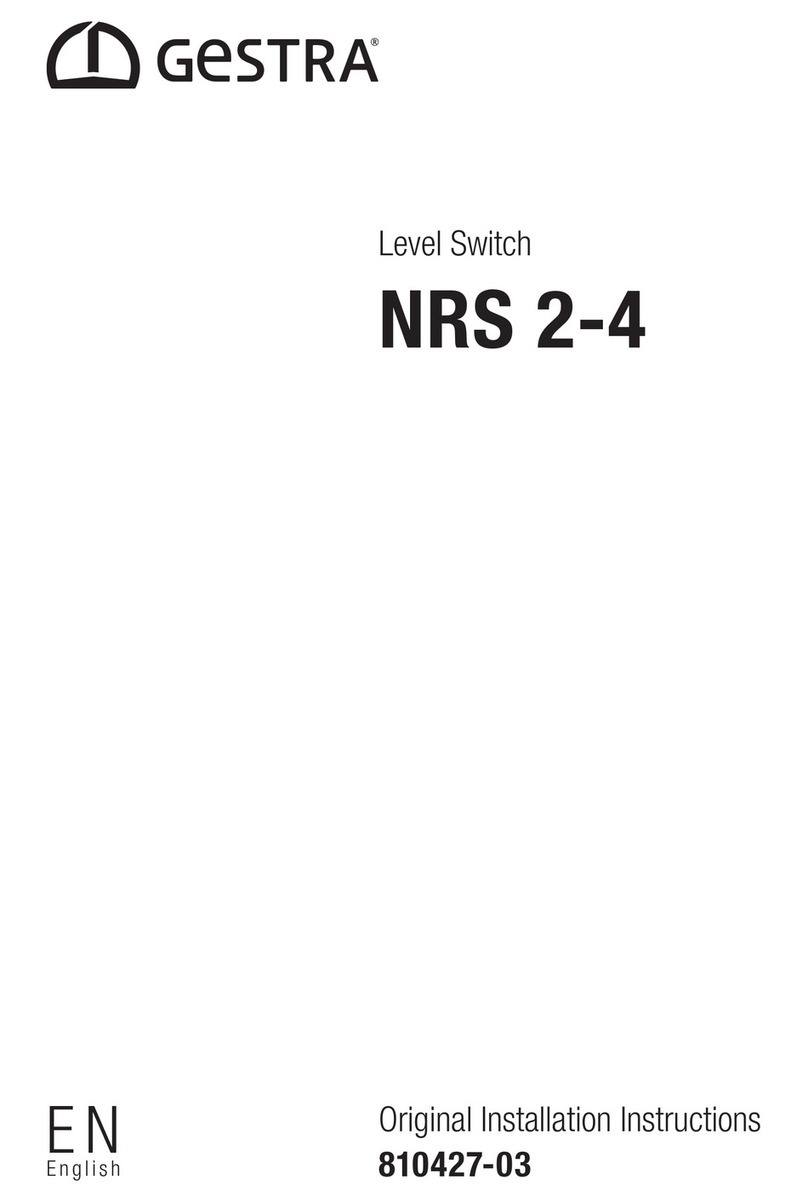
GESTRA
GESTRA NRS 2-4 User manual
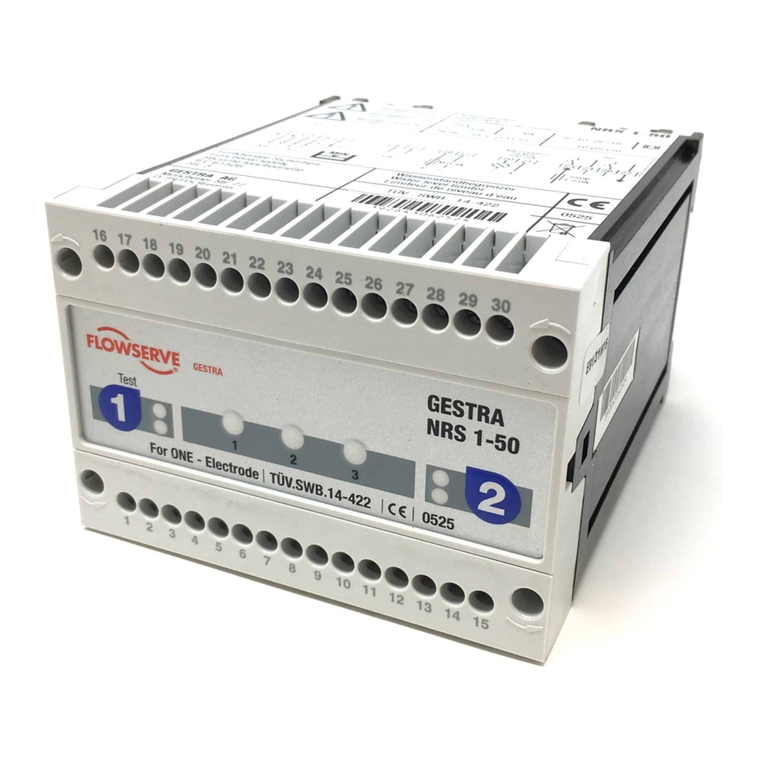
GESTRA
GESTRA NRS 1-50 Series User manual
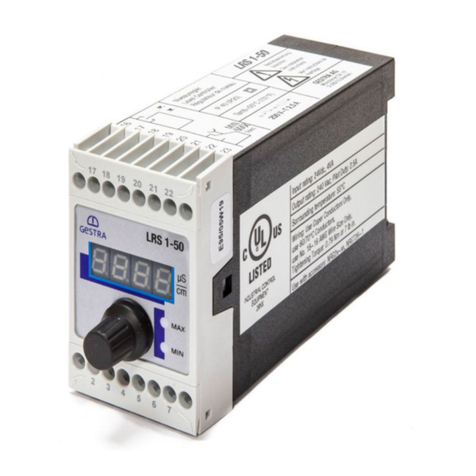
GESTRA
GESTRA LRS 1-50 User manual
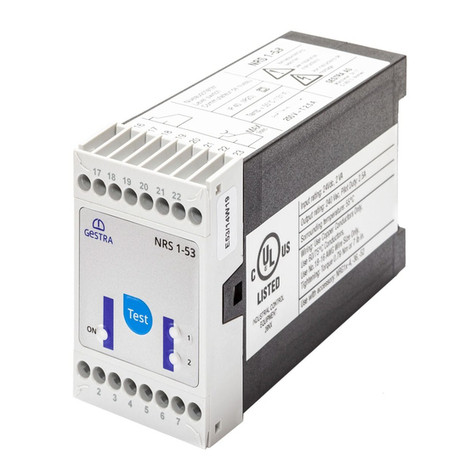
GESTRA
GESTRA NRS 1-53 User manual
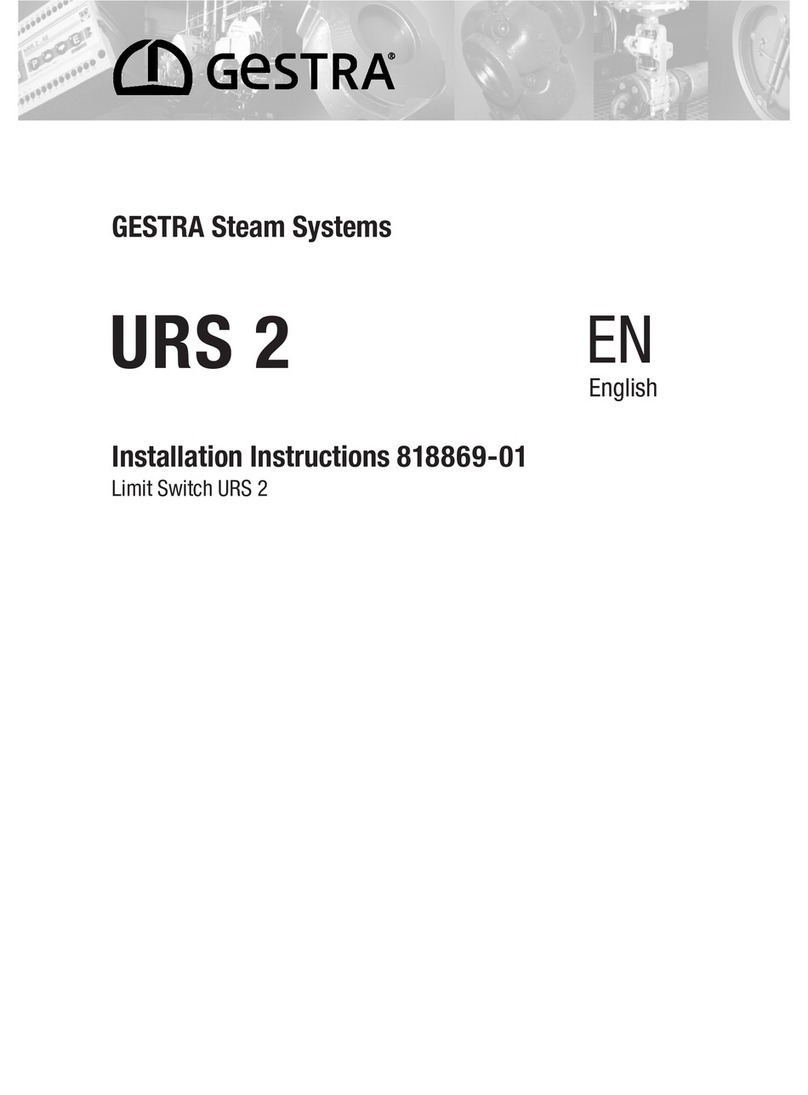
GESTRA
GESTRA URS 2 User manual
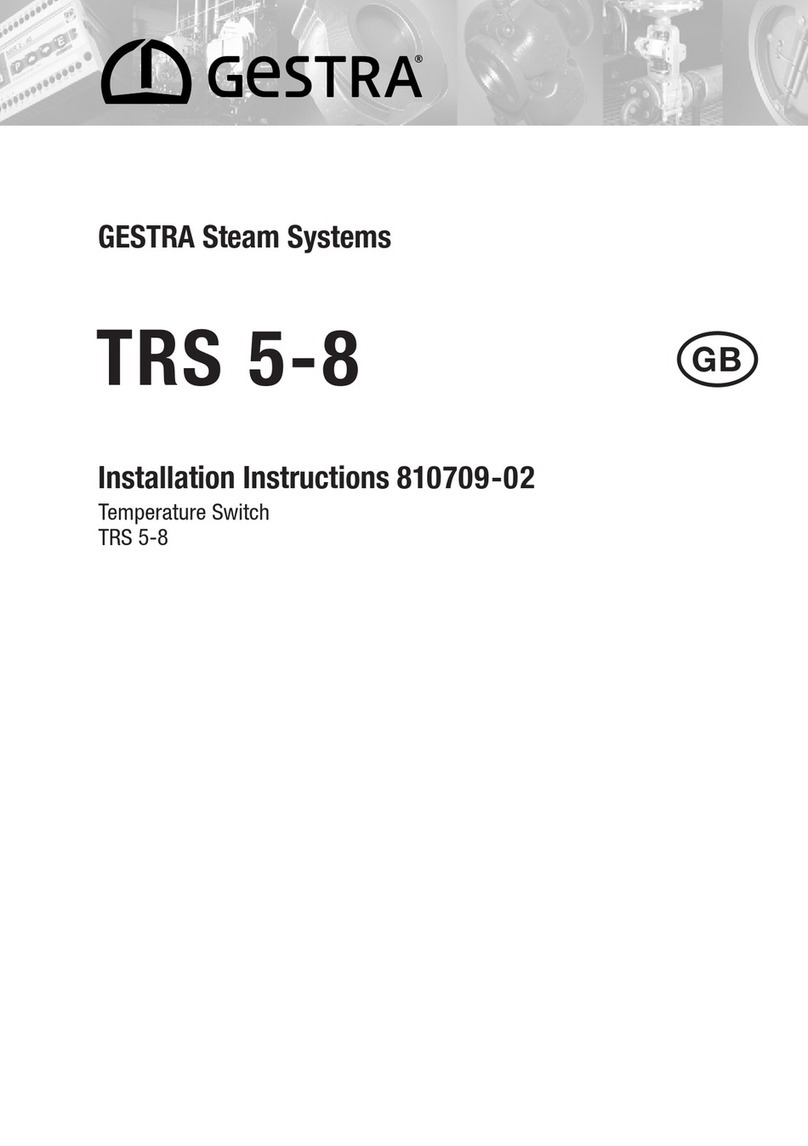
GESTRA
GESTRA TRS 5-8 User manual

GESTRA
GESTRA NRS 2-1 Quick guide
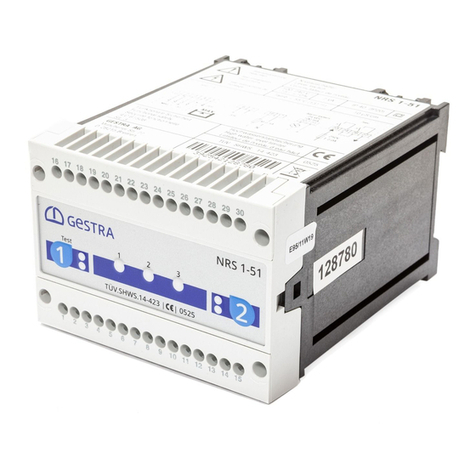
GESTRA
GESTRA NRS 1-51 User manual

GESTRA
GESTRA NRS 1-41 User manual
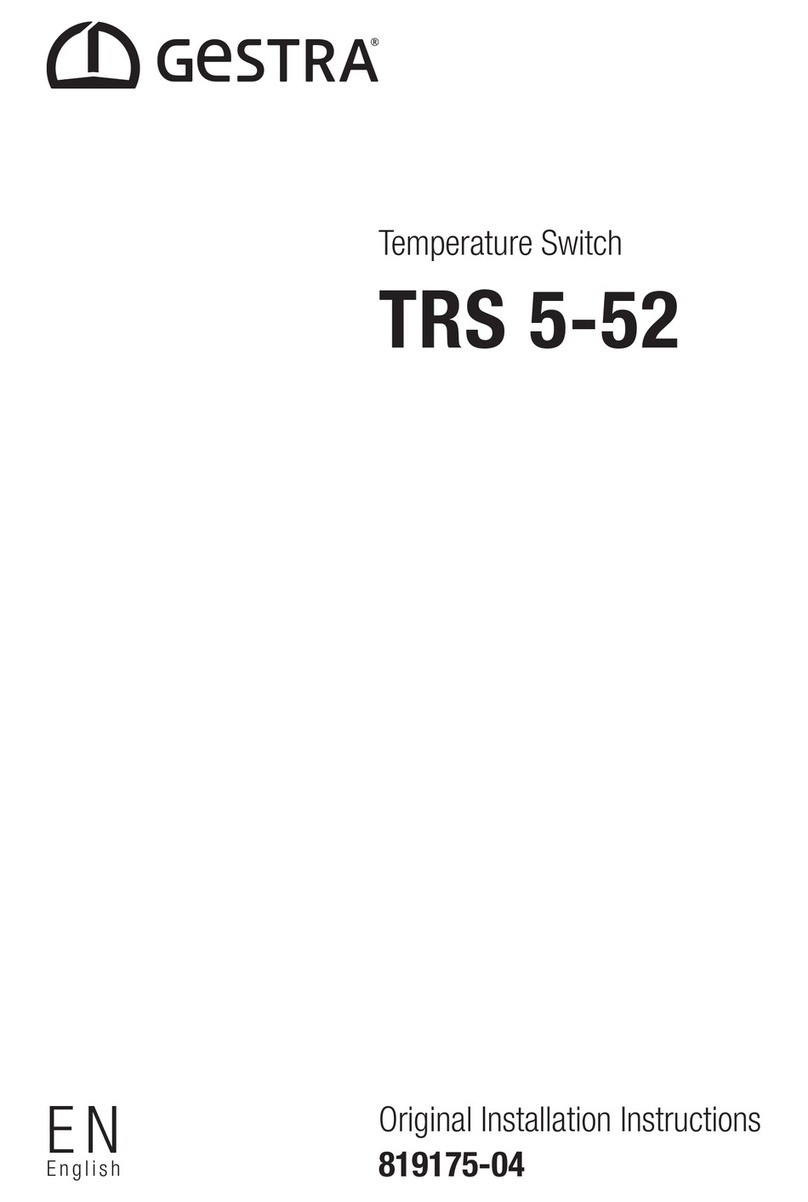
GESTRA
GESTRA TRS 5-52 User manual

GESTRA
GESTRA NRS 1-50 User manual
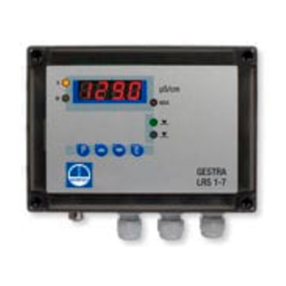
GESTRA
GESTRA LRS 1-7 Manual

GESTRA
GESTRA NRS 1-51 User manual
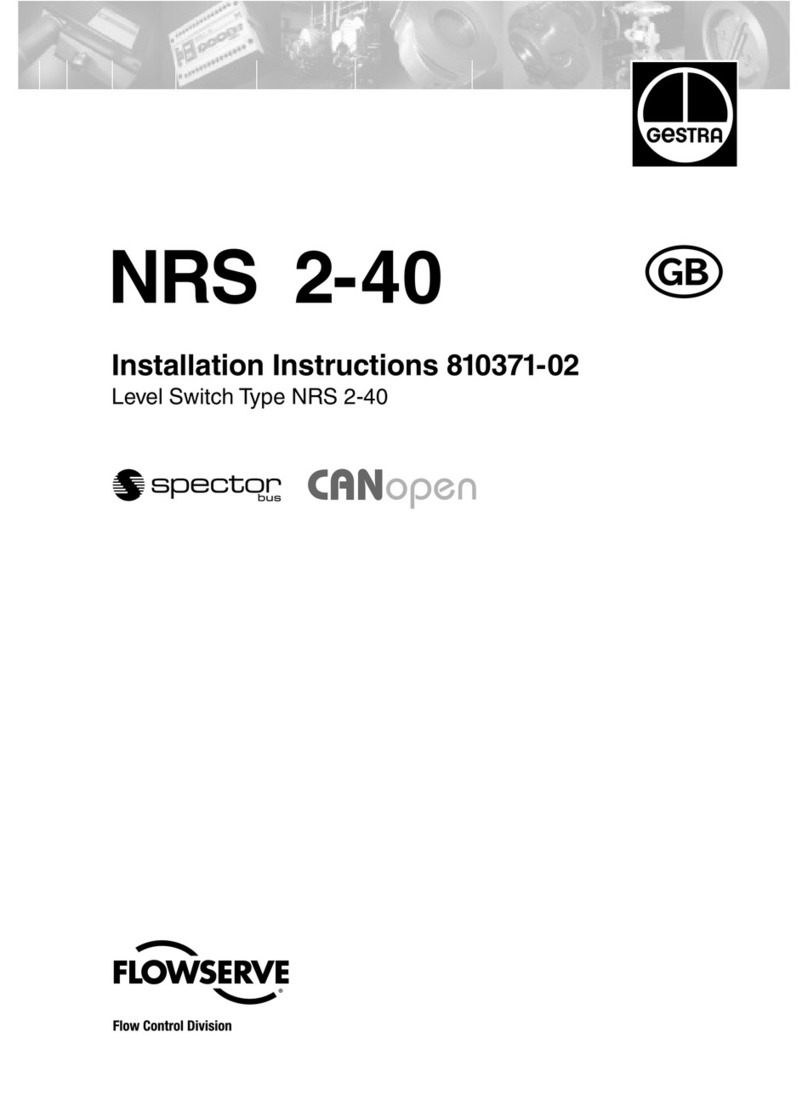
GESTRA
GESTRA NRS 2-40 User manual
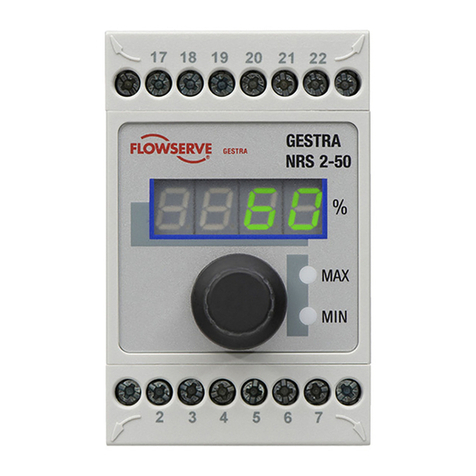
GESTRA
GESTRA NRS 2-50 User manual
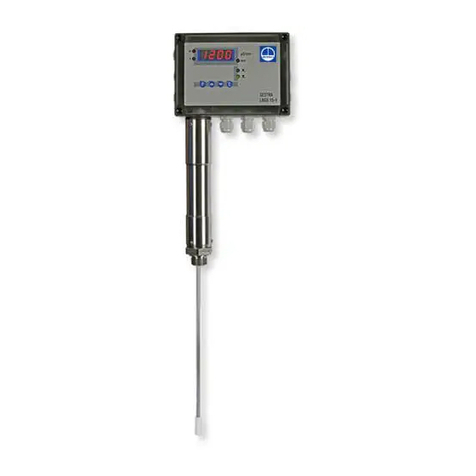
GESTRA
GESTRA LRGS 15-1 User manual

GESTRA
GESTRA NRS 2-50 User manual
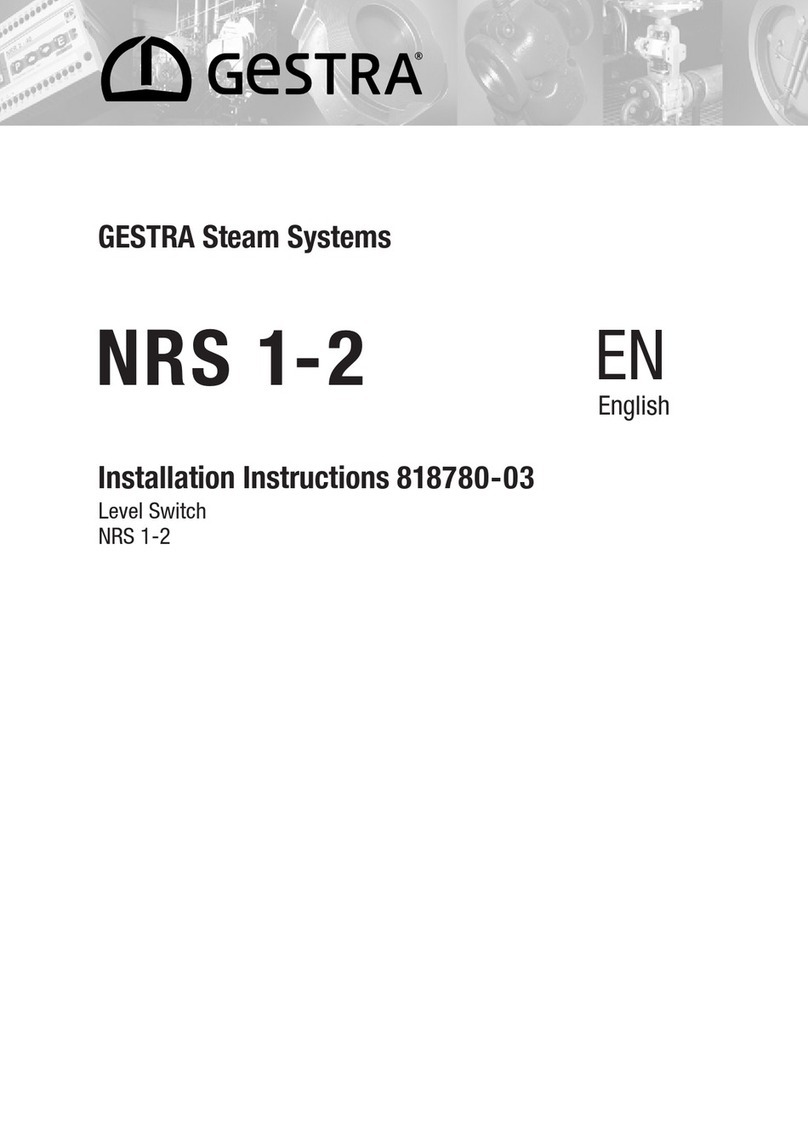
GESTRA
GESTRA NRS 1-2 User manual
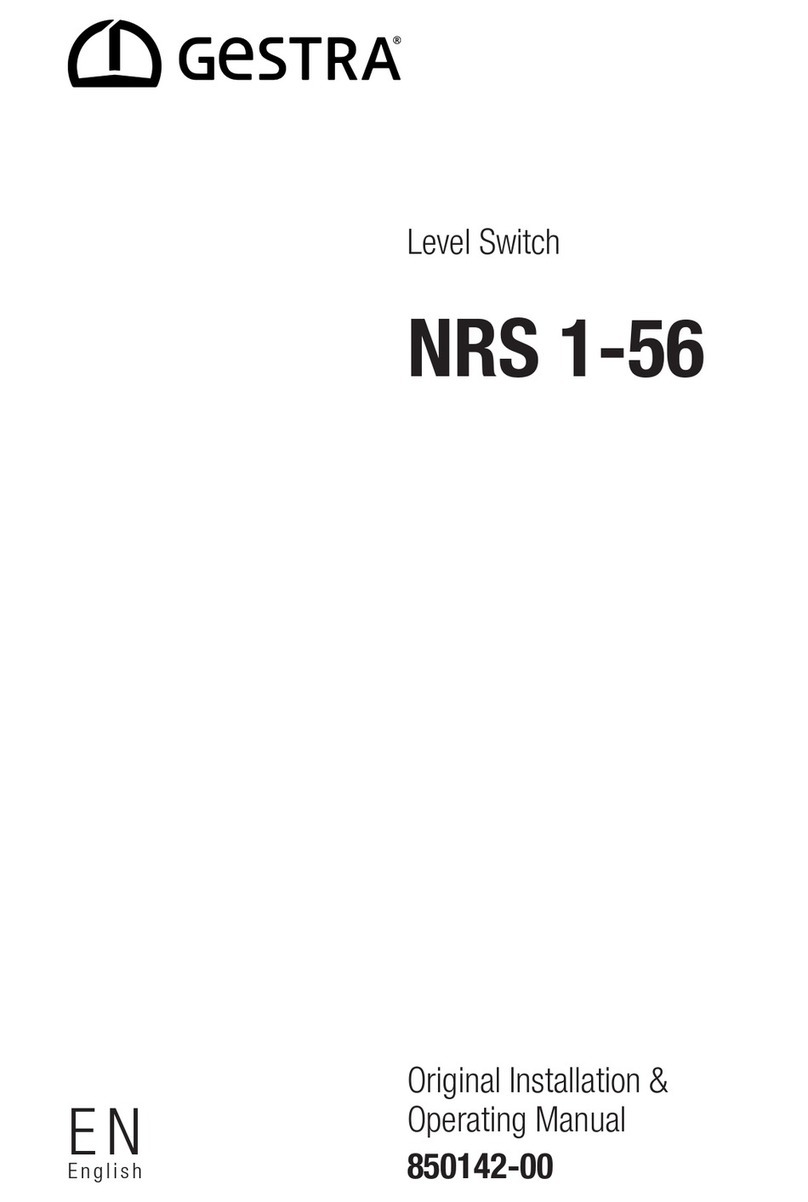
GESTRA
GESTRA NRS 1-56 User manual

GESTRA
GESTRA NRS 1-8 User manual


